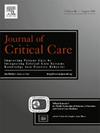Electrical impedance tomography to set high pressure in time-controlled adaptive ventilation
IF 3.2
3区 医学
Q2 CRITICAL CARE MEDICINE
引用次数: 0
Abstract
Introduction
TCAV (Time controlled adaptive ventilation), a combination of settings applied to the APRV (airway pressure release ventilation) mode, provides personalized ventilation tailored to the lung condition in ARDS (acute respiratory distress syndrome). The objective was to evaluate whether electrical impedance tomography (EIT) could serve as a tool for guiding Phigh level in TCAV for ARDS patients.
Methods
Eleven patients with moderate or severe ARDS were enrolled in a prospective single-center study in 2023. Patients were monitored with EIT (PulmoVista 500). Phigh trial was conducted from 34 to 18 cmH2O, with 4-cmH2O Phigh decrements every 5 min. Driving pressure was maintained constant by adjusting Tlow. Best EIT-derived-Phigh was defined as the pressure at the crossing point between overdistension and collapse curves.
Results
CRS was significantly higher at Phigh 18 cmH2O with 43 [32–50] mL/cmH2O than at Phigh 34 with 20 mL/cmH2O [14–24], p < 0.005. Highest Phigh levels caused significant overdistension in the anterior region and anterior compliance is significantly lower at Phigh 34 with 10 [6–11] mL/cmH2O than at Phigh 22 cmH2O with 18 [13–25] mL/cmH2O. Best EIT-derived Phigh were 18, 22, 26 cmH2O for four, five and two patients respectively.
Conclusion
EIT enabled detection of regional ventilation distribution on TCAV during a decremental Phigh trial and thus enabled the determination of a best EIT-derived-Phigh through an individualized approach, achieving best compromise between overdistension and collapse. The observed overdistention variability highlights the necessity of Phigh level personalization on TCAV.
求助全文
约1分钟内获得全文
求助全文
来源期刊

Journal of critical care
医学-危重病医学
CiteScore
8.60
自引率
2.70%
发文量
237
审稿时长
23 days
期刊介绍:
The Journal of Critical Care, the official publication of the World Federation of Societies of Intensive and Critical Care Medicine (WFSICCM), is a leading international, peer-reviewed journal providing original research, review articles, tutorials, and invited articles for physicians and allied health professionals involved in treating the critically ill. The Journal aims to improve patient care by furthering understanding of health systems research and its integration into clinical practice.
The Journal will include articles which discuss:
All aspects of health services research in critical care
System based practice in anesthesiology, perioperative and critical care medicine
The interface between anesthesiology, critical care medicine and pain
Integrating intraoperative management in preparation for postoperative critical care management and recovery
Optimizing patient management, i.e., exploring the interface between evidence-based principles or clinical insight into management and care of complex patients
The team approach in the OR and ICU
System-based research
Medical ethics
Technology in medicine
Seminars discussing current, state of the art, and sometimes controversial topics in anesthesiology, critical care medicine, and professional education
Residency Education.
 求助内容:
求助内容: 应助结果提醒方式:
应助结果提醒方式:


